Search the Gazetteer
Are the results not as expected? Modify your search term or change the scope to refine your search.
Results for a place that exactly matches ...
Durham
Durham, England
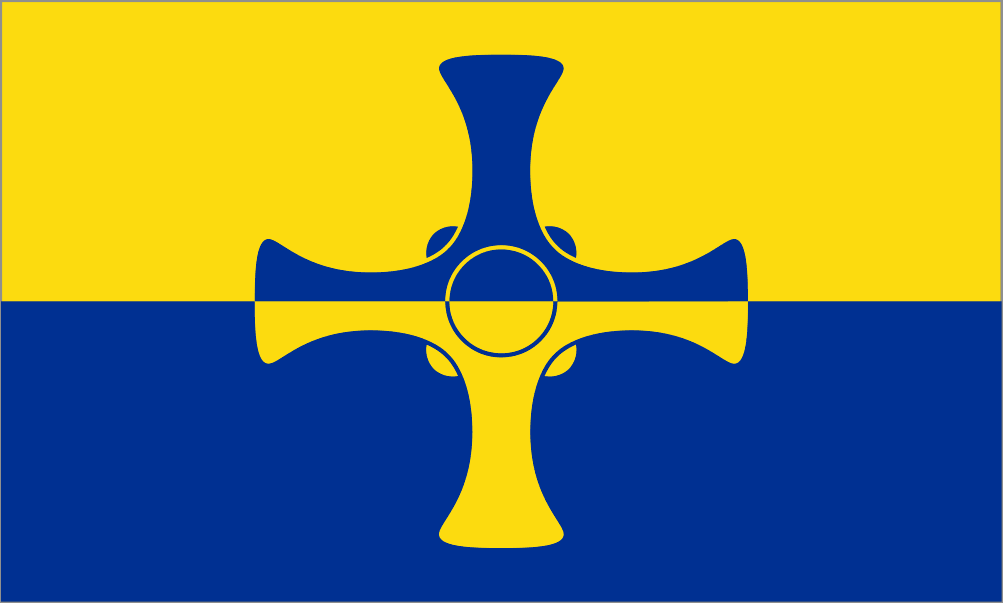 County Durham is a maritime county in the north-east of England. The county reaches from the North Sea up into the Pennines, separated from Northumberland by the rivers Tyne and Derwent and from Yorkshire by the Tees. The Durham Dales occupy the west of the county. The south lies within the broad plain of the Tees Lowlands – including the industrial towns of Darlington, Stockton-on-Tees, Billingham and the port of Hartlepool. The River Wear flows across the entire breadth of the county - through the ancient towns of Bishop Auckland, Durham, Chester-le-Street - reaching the sea at Sunderland. The north-east of the county is dominated by the towns which line the Tyne’s southern bank: the former mining towns of Ryton and Blaydon on Tyne; Gateshead – famous for its architecture; the shipbuilding town of Hebburn; Jarrow - home of Bede; and the port of South Shields. County Durham has a long and complex history and a proud heritage which derives from that.
County Durham is a maritime county in the north-east of England. The county reaches from the North Sea up into the Pennines, separated from Northumberland by the rivers Tyne and Derwent and from Yorkshire by the Tees. The Durham Dales occupy the west of the county. The south lies within the broad plain of the Tees Lowlands – including the industrial towns of Darlington, Stockton-on-Tees, Billingham and the port of Hartlepool. The River Wear flows across the entire breadth of the county - through the ancient towns of Bishop Auckland, Durham, Chester-le-Street - reaching the sea at Sunderland. The north-east of the county is dominated by the towns which line the Tyne’s southern bank: the former mining towns of Ryton and Blaydon on Tyne; Gateshead – famous for its architecture; the shipbuilding town of Hebburn; Jarrow - home of Bede; and the port of South Shields. County Durham has a long and complex history and a proud heritage which derives from that.Type: Historic County
Lat, Long: 54.722475,-1.709992
Grid Reference: NZ187364
Country: England
 Explore Durham on Wikishire
Explore Durham on Wikishire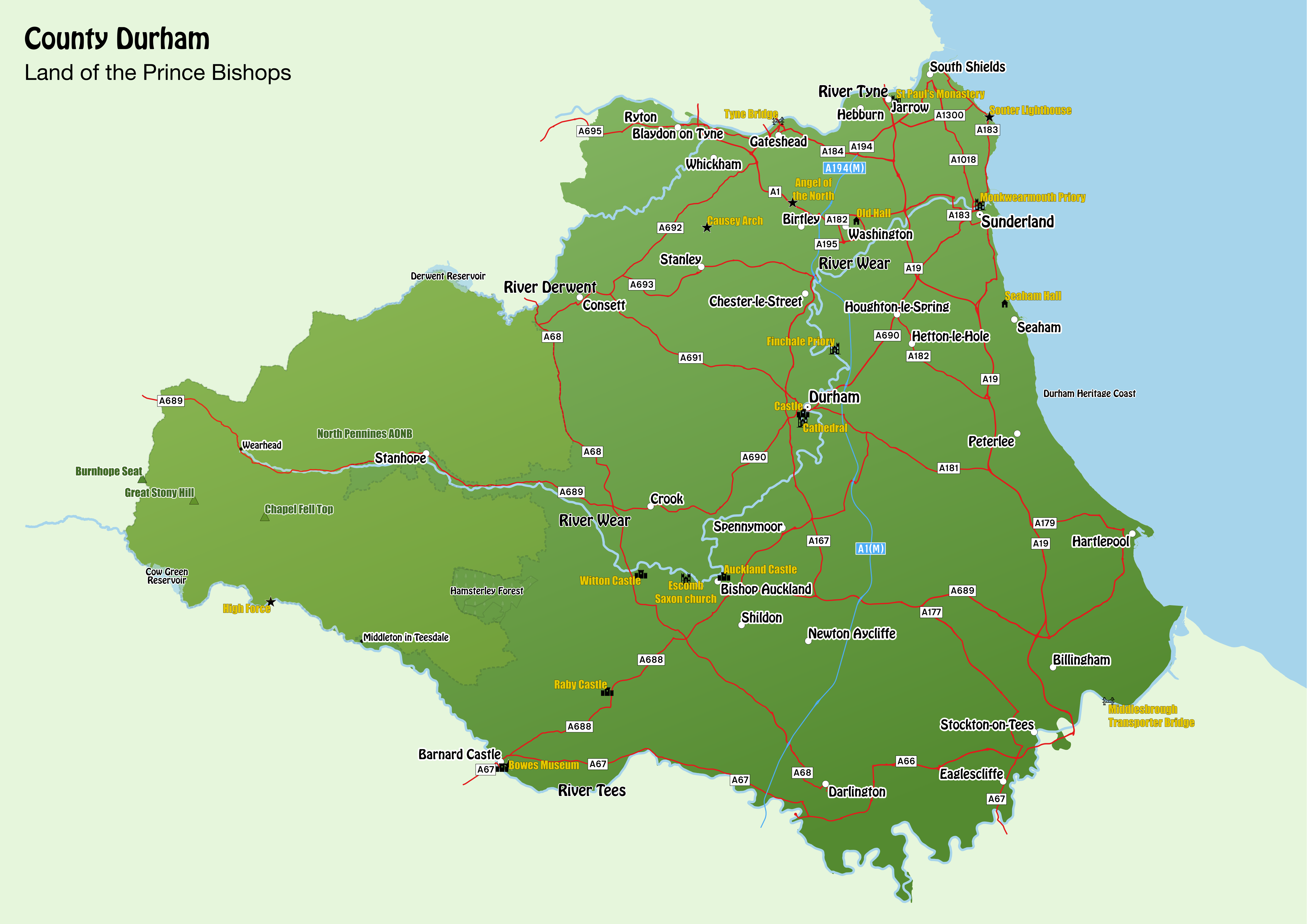
Known as "the Land of the Prince Bishops", the county was a county palatine under the rule of the Bishop of Durham from the Middle Ages until 1836. Durham's history was forged by the troubles of the Middle Ages. The Industrial Revolution prompted exploitation of its extensive coalfield, dramatically changing its character. New mining villages were built. Its towns developed as centres of heavy industry, particularly iron and steel production and shipbuilding. The decline of these industries has seen the character of the county change again, with the establishment of new towns, industrial and business parks, and a move towards light industry, technology, services and tourism.
The Durham Dales occupy the west of the county, a landscape of high exposed moorlands, hills and mountains. The River Tees rises in Cumberland before forming County Durham's border with Westmorland and then its long border with Yorkshire. County Durham's border with Cumberland runs across the peaks to where County Durham, Cumberland and Northumberland meet by Killhope Head. From here County Durham's border with Northumberland crosses the fells and thence along the River Derwent. Consett is perched on the steep eastern bank of the Derwent, on the edge of the Durham Dales.
At Wearhead, the River Wear starts its long, meandering journey through some of the county's best known towns and countryside. Upper Weardale is famed for its beauty, surrounded by high fells climbing up to 2,447 feet at Burnhope Seat (eastern summit), the county top, with heather grouse moors. The dale's principal villages include St John's Chapel, Stanhope and Wolsingham.
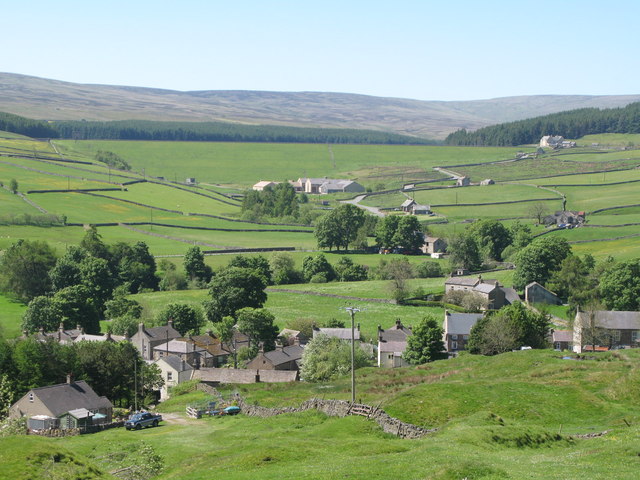
Wearhead
Upper Teesdale is a landscape of unrivalled drama. At High Force, the Tees plunges 70 feet over a rock precipice in one of Britain's greatest waterfalls. Middleton-in-Teesdale lies a little downstream, amongst the hills. Barnard Castle, famous for its Norman castle, lies on the edge of the Durham Dales. The Bowes Museum has a nationally renowned art collection housed in a 19th-century French-style chateau. The 14th-century Raby Castle, near Staindrop, is famed for both its size and its art.

Barnard Castle ruins
East from Staindrop, the south of the county lies within the Tees Lowlands, a broad, open plain dominated by the meandering River Tees and its tributaries. The whole area is gently undulating with wide views to the distant hills. Much of it remains a rural landscape of scattered small villages and farmsteads. Unspoilt villages, including Gainford, Carlbury, High Coniscliffe, Hurworth-on-Tees, Neasham and Middleton-one-Row, lie along the Tees.
Much of the Tees Lowlands is heavily urbanised. Newton Aycliffe was founded in 1947, one of the first of the post-war new towns. Darlington's development owes much to the local Quaker families of the Georgian and Victorian eras, who were instrumental in creating the Stockton and Darlington Railway, the world's first permanent passenger railway. Stockton-on-Tees, at the other end of the railway, grew on ship building, steel and chemicals. Billingham was founded circa 650 by a group of Angles known as Billa's people. The chemical industry played an important role in the growth of Billingham.
Hartlepool, a port town on the North Sea coast, was founded in the 7th century around Hartlepool Abbey. In the Middle Ages it served as the official port of the County Palatine of Durham. The port grew with the development of the Durham coalfield. A portion of the docklands has been converted into Hartlepool Marina.
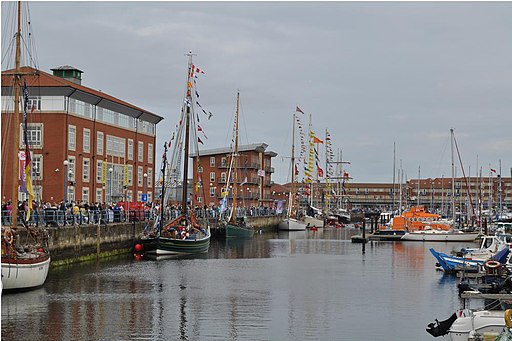
Hartlepool Marina
To the north of the Tees Lowlands is the East Durham Plateau, a low upland plateau of Magnesian Limestone falling eastwards to the sea and defined in the west by a prominent escarpment, from which there are panoramic views across the Wear lowlands to the Pennines. The heavy clay soils of the plateau support mixed, predominantly arable, farmland in an open rolling landscape of low hedges with few trees. The landscape has been heavily influenced by mining, quarrying and industry, its scattered mining towns and villages and busy roads giving it a semi-rural character in places.
The coast between Sunderland and Hartlepool used to be called the "black coast" following decades of coal waste being dumped directly onto the beach. Following a lengthy clean-up operation the coast has been reborn as the Durham Heritage Coast. The magnesian limestone that underlies this area has given rise to a spectacular landscape of cream-coloured cliffs intersected by denes.

The Durham Heritage Coast
Houghton-le-Spring and Hetton-le-Hole are large towns with long histories but which grew around the mining industry in the 19th century. Peterlee was a new town founded in 1948 and named after the celebrated Durham miners' leader Peter Lee. Seaham is a seaside town based around its harbour, constructed in 1828. At Seaham Hall, in 1815, Lord Byron married Anne Isabella Milbanke. Their short-lived union produced the mathematician Ada Lovelace.
Between the Durham Dales and the East Durham Plateau are the lowlands of the Wear Valley. The former mining town of Crook lies just north of the Wear at the edge of the Dales. Bishop Auckland lies on the Wear a few miles further south. Much of the town's early history was shaped by the Bishops of Durham who established a hunting lodge which later became their main residence, the splendid Auckland Castle. The route of the Roman road Dere Street passes through the town on its way to the Roman Fort at Binchester. The nearby village of Escomb has an Anglo-Saxon church built between 670 and 690.

Escomb church
The City of Durham rises magnificently on a hill surrounded by the River Wear, crowned by its huge Norman Cathedral. Behind the cathedral is a precipitous drop down to the river. This site was chosen in troubled times as a defensible spot by the guardians of the bones of Saint Cuthbert, which now lie within the Cathedral. Their settlement here was the effective foundation of Durham and its status. The cathedral, along with the nearby Durham Castle, is a UNESCO World Heritage Site. The remains of Finchale Priory, a 13th-century Benedictine priory, are sited by the Wear four miles from Durham.

Durham Cathedral above the Wear
The Wear flows north to the ancient town of Chester-le-Street. Here the Roman's built the fort of Concangis. This Roman fort is the "Chester" of the town's name; the "Street" refers to the paved Roman road that ran through the town. The parish church of St Mary and St Cuthbert is where the body of St Cuthbert remained for 112 years before being transferred to Durham Cathedral, and the site of the first translation of the Gospels into English.
Washington was designated a new town in 1964, though based around and retaining the older village of Washington. Washington Old Hall (NT) is an early-17th-century manor house, with a 13th-century Great Hall. The manor was the ancestral home of the family of George Washington.

Washington Old Hall
At the mouth of the Wear lies the city of Sunderland. Sunderland began as a fishing settlement before being granted a charter in 1179. Sunderland grew as a port, trading coal and salt. Ships began to be built on the river in the 14th century. By the 19th century, the port of Sunderland had absorbed Bishopwearmouth and Monkwearmouth. Since the decline of the city's traditional industries, the area has become a commercial centre for the automotive industry, science and technology and the service sector. To the north of Sunderland are the resort town of Seaburn and the village of Whitburn, with its 18th-century windmill looking out to sea.

St Peter's Church, Monkwearmouth
The north-east of County Durham is formed by the lowland plain south of the River Tyne and dominated by the towns which line the river's southern bank. At the west of this stretch of the river are the former mining towns Ryton and Blaydon-on-Tyne. Whickham is a prosperous commuter town. Near to the former mining town of Stanley is the Causey Arch, the oldest surviving single-arch railway bridge in the world.
Gateshead lies on the Tyne, opposite Newcastle upon Tyne and joined to it by seven bridges, including the landmark Gateshead Millennium Bridge. The town's economy is still based around the Team Valley trading estate, established in the 1930s. Gateshead is known for its iconic architecture such as The Sage Gateshead, the Angel of the North and the Baltic Centre for Contemporary Art.

Gateshead Millennium Bridge and the Baltic Art Gallery on the near bank (County Durham) with Newcastle upon Tyne (Northumberland) on the far bank.
East of Gateshead lie Hebburn and Jarrow. Jarrow is world famous for its association with the Venerable Bede who lived, worked and died at St Paul's monastery here. The monastery was founded by Benedict Biscop in 682 and a companion to the St Peter's monastery he founded at Monkwearmouth in 674. The abbot Ceolfrith established the monastery as a centre of learning and scholarship. Bede composed the first book of English history; The Ecclesiastical History of the English People, creating the narrative which all future works were to follow. Both houses were sacked by Viking raiders, subsequently abandoned, but then refounded as cells of Durham Priory in the 14th century. Since the dissolution, the two abbey churches have formed the parish churches of Monkwearmouth and Jarrow. At Jarrow, substantial ruins survive next to St Paul's church.

St Paul's monastery, Jarrow
South Shields lies at the mouth of the Tyne, built on its docks and the industry that came with them. It remains one of the most important ports in the kingdom. The town's North Sea coast has extensive beaches as well as the dramatic magnesian limestone cliffs of The Leas (NT). Marsden Bay, with its famous Marsden Rock, is home to a huge seabird colony. Souter Lighthouse (NT) (1871) was the first lighthouse in the world designed and built to be powered by electricity.

South Lighthouse
The lands of County Durham were part of the Kingdom of Northumbria from its foundation until the Viking incursions. In 866 Ivar the Boneless captured York and reduced the Northumbrian kingdom to just Durham and Northumberland. The lands that became County Durham were originally a liberty under the control of the Bishops of Durham, known variously as the "Liberty of Durham", "Liberty of St Cuthbert's Land" "The lands of St Cuthbert between Tyne and Tees" or "The Liberty of Haliwerfolc". The bishops' special jurisdiction was based on claims that King Ecgfrith of the Northumbrians had granted a substantial territory to St Cuthbert on his election to the see of Lindisfarne in 684. In about 883, a cathedral housing the saint's remains was established at Chester-le-Street and Guthfrith, the Norse King of York, granted the community of St Cuthbert the area between the Tyne and the Wear. In 995 the see was moved again to the more defensive position of Durham.
In the 12th century a shire or county of Northumberland was formed. The crown still regarded Durham as falling within Northumberland until the late 13th century. In 1293 the bishop and his steward failed to attend proceedings of quo warranto held by the justices of Northumberland. The bishops' case was heard in parliament, where he stated that Durham lay outside the bounds of any English shire and that "from time immemorial it had been widely known that the sheriff of Northumberland was not sheriff of Durham nor entered within that liberty as sheriff. . . nor made there proclamations or attachments". By the 14th century Durham was accepted as a liberty which received royal mandates direct. In effect it was a private shire, with the bishop appointing his own sheriff. The area eventually became known as the "County Palatine of Durham".
The County Durham flag was launched in 2013 and features the Cross of Cuthbert, counterchanged on the county colours of blue and gold. County Durham Day is celebrated on 20th March, the date of Saint Cuthbert's death.
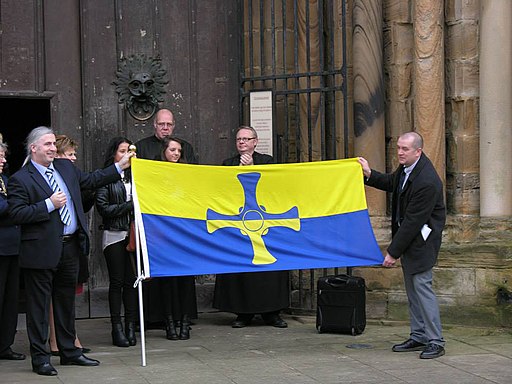
County Durham Flag unfurling ceremony


 Menu
Menu